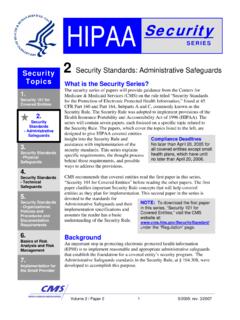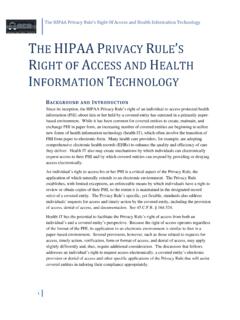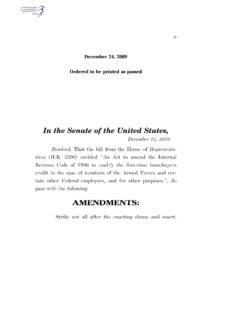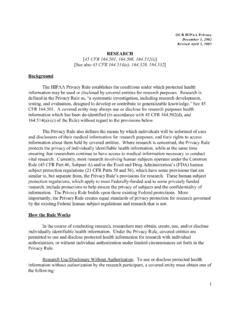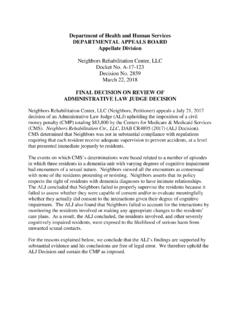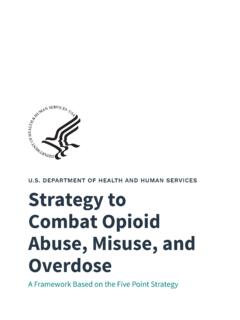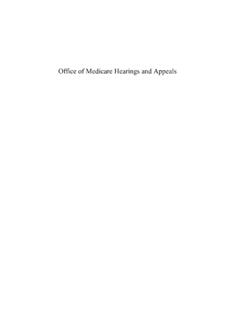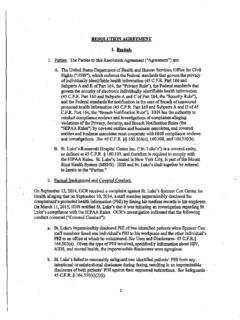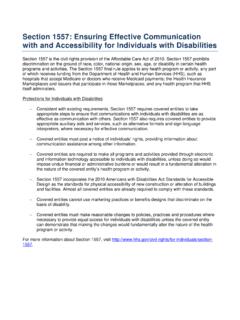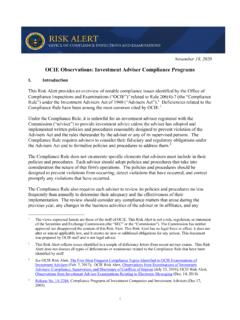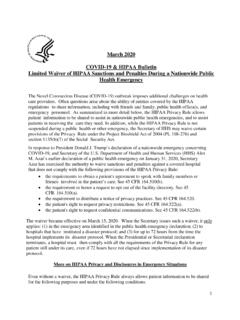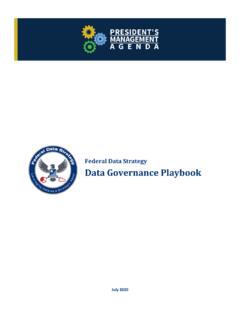Transcription of COVID-19 and HIPAA: Disclosures to law enforcement ...
1 1 COVID-19 and HIPAA: Disclosures to law enforcement , paramedics, other first responders and public health authorities Does the Health Insurance Portability and Accountability Act (HIPAA) Privacy Rule allow a covered entity to share the name or other identifying information of an individual who has been infected with, or exposed to, the virus SARS-CoV-2, or the disease caused by the virus, Coronavirus Disease 2019 ( COVID-19 ), with law enforcement , paramedics, other first responders, and public health authorities without an individual s authorization? Yes, the HIPAA Privacy Rule permits a covered entity to disclose the protected health information (PHI) of an individual who has been infected with, or exposed to, COVID-19 , with law enforcement , paramedics, other first responders, and public health authorities1 without the individual s HIPAA authorization, in certain circumstances, including the following2: When the disclosure is needed to provide treatment.
2 For example, HIPAA permits a covered skilled nursing facility to disclose PHI about an individual who has COVID-19 to emergency medical transport personnel who will provide treatment while transporting the individual to a hospital s emergency department. 45 CFR (a)(1)(ii); 45 CFR (c)(2). When such notification is required by law. For example, HIPAA permits a covered entity, such as a hospital, to disclose PHI about an individual who tests positive for COVID-19 in accordance with a state law requiring the reporting of confirmed or suspected cases of infectious disease to public health officials. 45 CFR (a). To notify a public health authority in order to prevent or control spread of disease. For example, HIPAA permits a covered entity to disclose PHI to a public health authority 1 Under HIPAA, public health authority means an agency or authority of the United States, a State, a territory, a political subdivision of a State or territory, or an Indian tribe, or a person or entity acting under a grant of authority from or contract with such public agency, including the employees or agents of such public agency or its contractors or persons or entities to whom it has granted authority, that is responsible for public health matters as part of its official mandate.
3 45 CFR (definition of "public health authority"). 2 The HIPAA Privacy Rule limitations only apply if the entity or individual that is disclosing protected health information meets the definition of a HIPAA covered entity or business associate. This guidance provides examples of Disclosures from certain types of entities, some of which are covered by HIPAA, and others that may not be. While the entities in the examples are covered under HIPAA, the examples are not intended to imply that all public health authorities, 911 call centers, or prison doctors, for example, are covered by HIPAA and are required to comply with the HIPAA Rules. 2 (such as the Centers for Disease Control and Prevention (CDC), or state, tribal, local, and territorial public health departments) that is authorized by law to collect or receive PHI for the purpose of preventing or controlling disease, injury, or disability, including for public health surveillance, public health investigations, and public health interventions.
4 45 CFR (b)(1)(i); see also 45 CFR (providing the definition of public health authority ). When first responders may be at risk of infection. A covered entity may disclose PHI to a first responder who may have been exposed to COVID-19 , or may otherwise be at risk of contracting or spreading COVID-19 , if the covered entity is authorized by law, such as state law, to notify persons as necessary in the conduct of a public health intervention or investigation. For example, HIPAA permits a covered county health department, in accordance with a state law, to disclose PHI to a police officer or other person who may come into contact with a person who tested positive for COVID-19 , for purposes of preventing or controlling the spread of COVID-19 . 45 CFR (b)(1)(iv). When the disclosure of PHI to first responders is necessary to prevent or lessen a serious and imminent threat to the health and safety of a person or the public. A covered entity may disclose PHI to prevent or lessen a serious and imminent threat to a person or the public, when such disclosure is made to someone they believe can prevent or lessen the threat, which may include the target of the threat.
5 For example, HIPAA permits a covered entity, consistent with applicable law and standards of ethical conduct, to disclose PHI about individuals who have tested positive for COVID-19 to fire department personnel, child welfare workers, mental health crisis services personnel, or others charged with protecting the health or safety of the public if the covered entity believes in good faith that the disclosure of the information is necessary to prevent or minimize the threat of imminent exposure to such personnel in the discharge of their duties. 45 CFR (j)(1). When responding to a request for PHI by a correctional institution or law enforcement official having lawful custody of an inmate or other individual, if the facility or official represents that the PHI is needed for: o providing health care to the individual; o the health and safety of the individual, other inmates, officers, employees and others present at the correctional institution, or persons responsible for the transporting or transferring of inmates; o law enforcement on the premises of the correctional institution; or o the administration and maintenance of the safety, security , and good order of the correctional institution.
6 For example, HIPAA permits a covered entity, such as a physician, located at a prison medical facility to share an inmate s positive COVID-19 test results with correctional officers at the facility for the health and safety of all people at the facility. 45 CFR (k)(5). 3 General Considerations: Except when required by law, or for treatment Disclosures , a covered entity must make reasonable efforts to limit the information used or disclosed under any provision listed above to that which is the minimum necessary to accomplish the purpose for the disclosure. 45 CFR (b). In some cases, more than one provision of the HIPAA Privacy Rule may apply to permit a particular use or disclosure of PHI by a covered entity. The illustrative examples below involve uses and Disclosures of PHI that are permitted under 45 CFR (a), (b)(1), and/or (j)(1), depending on the circumstances. ADDITIONAL EXAMPLES: Example: A covered entity, such as a hospital, may provide a list of the names and addresses of all individuals it knows to have tested positive, or received treatment, for COVID-19 to an EMS dispatch for use on a per-call basis.
7 The EMS dispatch (even if it is a covered entity) would be allowed to use information on the list to inform EMS personnel who are responding to any particular emergency call so that they can take extra precautions or use personal protective equipment (PPE). Discussion: Under this example, a covered entity should not post the contents of such a list publicly, such as on a website or through distribution to the media. A covered entity under this example also should not distribute compiled lists of individuals to EMS personnel, and instead should disclose only an individual s information on a per-call basis. Sharing the lists or disclosing the contents publicly would not ordinarily constitute the minimum necessary to accomplish the purpose of the disclosure ( , protecting the health and safety of the first responders from infectious disease for each particular call). Example: A 911 call center may ask screening questions of all callers, for example, their temperature, or whether they have a cough or difficulty breathing, to identify potential cases of COVID-19 .
8 To the extent that the call center may be a HIPAA covered entity, the call center is permitted to inform a police officer being dispatched to the scene of the name, address, and screening results of the persons who may be encountered so that the officer can take extra precautions or use PPE to lessen the officer s risk of exposure to COVID-19 , even if the subject of the dispatch is for a non-medical situation. Discussion: Under this example, a 911 call center that is a covered entity should only disclose the minimum amount of information that the officer needs to take appropriate precautions to minimize the risk of exposure. Depending on the circumstances, the minimum necessary PHI may include, for example, an individual s name and the result of the screening. 4 Covered entities should consult other applicable laws ( , state and local statutes and regulations) in their jurisdiction prior to using or making Disclosures of individuals PHI, as such laws may place further restrictions on Disclosures that are permitted by HIPAA.
9 Resources The CDC s National Institute for Occupational Safety and Health (NIOSH) has published a document that adds COVID-19 to its list of potentially life-threatening infectious diseases to which emergency response employees (EREs) may be exposed while transporting or assisting victims of emergencies, and for which the medical facilities receiving the victims of emergencies would be required by law to notify the EREs of the potential exposure for purposes of the EREs seeking necessary diagnosis or medical treatment. More information is available at Information about HIPAA Privacy and COVID-19 is available at Information about Disclosures of PHI to law enforcement officials is available in OCR s HIPAA Guide for Law enforcement at Information about uses and Disclosures of PHI for public health is available at
